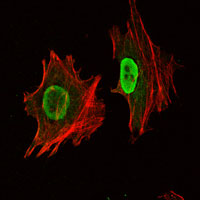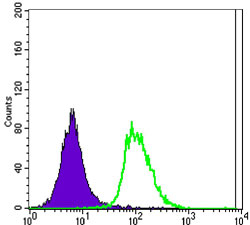Oct4 Antibody
Purified Mouse Monoclonal Antibody
- 产品详情
- 实验流程
Application
| WB, FC, ICC, E |
|---|---|
| Primary Accession | Q01860 |
| Reactivity | Human |
| Host | Mouse |
| Clonality | Monoclonal |
| Clone Names | 7E7 |
| Isotype | IgG1 |
| Calculated MW | 38571 Da |
| Description | This gene encodes a transcription factor containing a POU homeodomain. This transcription factor plays a role in embryonic development, especially during early embryogenesis, and it is necessary for embryonic stem cell pluripotency. A translocation of this gene with the Ewing's sarcoma gene, t(6;22)(p21;q12), has been linked to tumor formation. Alternative splicing, as well as usage of alternative translation initiation codons, results in multiple isoforms, one of which initiates at a non-AUG (CUG) start codon. Related pseudogenes have been identified on chromosomes 1, 3, 8, 10, and 12. (provided by RefSeq).Tissue specificity: Expressed in developing brain. Highest levels found in specific cell layers of the cortex, the olfactory bulb, the hippocampus and the cerebellum. Low levels of expression in adult tissues. |
| Immunogen | Synthesized peptide derived from internal of human Oct4. |
| Formulation | Ascitic fluid containing 0.03% sodium azide. |
| Gene ID | 5460 |
|---|---|
| Other Names | POU domain, class 5, transcription factor 1, Octamer-binding protein 3, Oct-3, Octamer-binding protein 4, Oct-4, Octamer-binding transcription factor 3, OTF-3, POU5F1, OCT3, OCT4, OTF3 |
| Dilution | WB~~1/500 - 1/2000 FC~~1/200 - 1/400 ICC~~N/A E~~N/A |
| Storage | Maintain refrigerated at 2-8°C for up to 6 months. For long term storage store at -20°C in small aliquots to prevent freeze-thaw cycles. |
| Precautions | Oct4 Antibody is for research use only and not for use in diagnostic or therapeutic procedures. |
| Name | POU5F1 |
|---|---|
| Synonyms | OCT3, OCT4, OTF3 |
| Function | Transcription factor that binds to the octamer motif (5'- ATTTGCAT-3'). Forms a trimeric complex with SOX2 or SOX15 on DNA and controls the expression of a number of genes involved in embryonic development such as YES1, FGF4, UTF1 and ZFP206. Critical for early embryogenesis and for embryonic stem cell pluripotency. |
| Cellular Location | Cytoplasm. Nucleus. Note=Expressed in a diffuse and slightly punctuate pattern. Colocalizes with MAPK8 and MAPK9 in the nucleus. {ECO:0000250|UniProtKB:P20263, ECO:0000269|PubMed:18191611, ECO:0000269|PubMed:19274063, ECO:0000269|PubMed:23024368} |
| Tissue Location | Expressed in developing brain. Highest levels found in specific cell layers of the cortex, the olfactory bulb, the hippocampus and the cerebellum. Low levels of expression in adult tissues. |
Research Areas
For Research Use Only. Not For Use In Diagnostic Procedures.
Application Protocols
Provided below are standard protocols that you may find useful for product applications.
REFERENCES
1. Stem Cells. 2010 May;28(5):885-93. 2. Mol Med. 2010 Jul-Aug;16(7-8):247-53. 3. Med Sci (Paris). 2010 Apr;26(4):411-6.
终于等到您。ABCEPTA(百远生物)抗体产品。
点击下方“我要评价 ”按钮提交您的反馈信息,您的反馈和评价是我们最宝贵的财富之一,
我们将在1-3个工作日内处理您的反馈信息。
如有疑问,联系:0512-88856768 tech-china@abcepta.com.























 癌症的基本特征包括细胞增殖、血管生成、迁移、凋亡逃避机制和细胞永生等。找到癌症发生过程中这些通路的关键标记物和对应的抗体用于检测至关重要。
癌症的基本特征包括细胞增殖、血管生成、迁移、凋亡逃避机制和细胞永生等。找到癌症发生过程中这些通路的关键标记物和对应的抗体用于检测至关重要。 为您推荐一个泛素化位点预测神器——泛素化分析工具,可以为您的蛋白的泛素化位点作出预测和评分。
为您推荐一个泛素化位点预测神器——泛素化分析工具,可以为您的蛋白的泛素化位点作出预测和评分。 细胞自噬受体图形绘图工具为你的蛋白的细胞受体结合位点作出预测和评分,识别结合到自噬通路中的蛋白是非常重要的,便于让我们理解自噬在正常生理、病理过程中的作用,如发育、细胞分化、神经退化性疾病、压力条件下、感染和癌症。
细胞自噬受体图形绘图工具为你的蛋白的细胞受体结合位点作出预测和评分,识别结合到自噬通路中的蛋白是非常重要的,便于让我们理解自噬在正常生理、病理过程中的作用,如发育、细胞分化、神经退化性疾病、压力条件下、感染和癌症。








